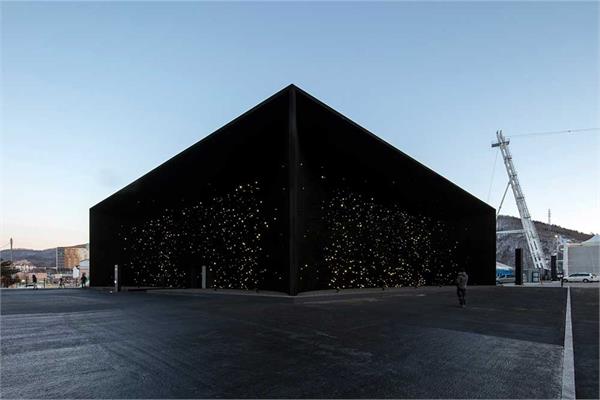
Asif Khan has unveiled a pavilion at the Pyeongchang Winter Olympic Games in South Korea, described as the "darkest building on earth".
The British architect spray-painted the 10-metre-high temporary structure with Vantablack VBx2, a substance that absorbs over 99% of light.
Vantablack VBx2, is a sprayable version of Vantablack pigment, which British artist Anish Kapoor controversially acquired exclusive rights for in 2016.
Rods tipped with tiny white lights protrude from the "super-black" parabolic curves of all four sides of the pavilion, giving the impression of stars suspended against the darkness of space.
Speaking to Dezeen, Khan – who describes himself as a "closet astronaut" – said he "wanted to create the impression of a window cut into space".
"It's a preoccupation of mine, trying to create experiences to better understand where we are now as humans, placing ourselves in the big picture," said Khan. "I'm interested in that feeling of the sublime when you pull back the curtain of reality. It's a different way of experiencing architecture."
The sprayable Vantablack VBx2, is so black that it is almost impossible for the human eye to perceive the shape of an object it coats.
"It changes as you approach it. From far away you see it as a surface of blackness, it just looks like a void," said Khan. "As you approach you pick out the stars, and as you get closer the stars begin to move in parallax, which means they appear as a three dimensional body. As you walk past it they're almost globular in their clustering."
The light-absorbing power of Vantablack VBx2 and the optical illusions created by the lights against the curved walls is almost too difficult for humans to comprehend, according to the architect.
"There's a tension between wanting to know what form something is and actually accepting that it could be formless – you're looking at infinity," he said.
Khan had been in contact with the scientists behind the original Vantablack, since 2013, after reading a paper on the subject while researching how to create a building that could be as black as space.
"They were quite taken aback that someone would think to try and apply their materials in the built environment," he said. "They're a bunch of very skilled scientists who are working a lot of the time in a laboratory. They are working at nanoscale and the idea of making something that's millions of times bigger than that hadn't really come into their minds."
Khan and the scientists first collaborated on a proposal using the material for the UK Pavilion at Milan Expo 2015, which was eventually shortlisted.
In the meantime, the manufacturers devised Vantablack VBx2, a more versatile material better suited to architectural application. The light-absorbing pigmented coating is suspended in a carrier solution that allows it to be sprayed onto larger areas.
"This was the real challenge, actually going from the lab to full scale manufacturing, which they pulled off. It's amazing," said Khan.
The Vantablack used for Khan's building is structurally different to the original pigment. Whereas the black Kapoor has rights over uses microscopic stems to absorb light, VBx2 has a sponge-like structure at micro level.
To build the PyeongChang Winter Olympics pavilion, the steel substructure was bolted together on site and then clad to create the curved surfaces.
A scaffold was then erected around the pavilion and tented, creating conditions suitable for spray painting. During construction the team had to contend with the mountain climate and temperatures between -15°C and -25°C .
"It's a challenging climate to work in, because of the temperature, because of the extreme high winds. On an Olympic Park you don't have much of a time frame to get anything wrong," said Khan.
When it opens on 9 February 2018, visitors will be able to enter the pavilion through a dark corridor that opens into a bright white space lined with solid-surface material Corian. Channels have been carved into its surface as part of a multi-sensory hydrophobic water installation also designed by Khan.
Walking across a pathway, visitors interact with sensors causing 25,000 water droplets a minute to whizz along the channels, colliding and splitting before pooling into a lake.
The 35-metre by 35-metre building was commissioned by Hyundai Motor as part of its global art initiative, with the pavilion's space theme aligning with the car manufacturer's latest technology: a Hydrogen Fuel Cell vehicle.
The "stars" on the outside represent the chemical element on a cosmic level – gaseous balls shining due to the thermonuclear fusion of hydrogen into helium at their core.
Inside the pavilion, the liquid embodies hydrogen at a more human scale, as two atoms of hydrogen bond with one oxygen atom to form water.
The building also references its location in South Korea. The curved wall of the building makes it star-shaped in plan, yet rectangular in elevation, while the shape formed by the intersection of the curved walls echoes the swooping roofs of traditional temple architecture.
Photos © Luke Hayes
Text © India Block for Dezeen